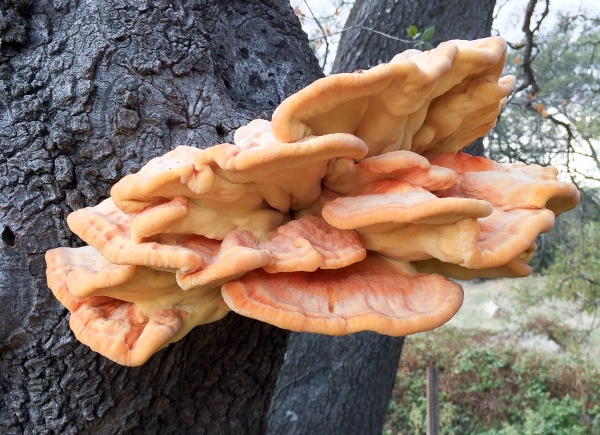Laetiporus gilbertsonii is another of my favorite mushrooms. It was the first wild mushroom that I’ve trusted enough to eat, and it’s the wild mushroom I use as an ambassador for foraging and wild mushroom consumption. To me at least, this mushroom tastes like fried chicken breast, with occasional bursts of fresh lemon. The texture is firmer than normal cooked white mushrooms. It’s absolutely fantastic, and probably the best thing I’ve ever eaten. No joke.
L. gilbertsonii is the west-coast non-conifer sulphur shelf. In older field guides, including the wonderful Mushrooms Demystified, it’s described under L. sulphureus. It wasn’t until recently that the different species of this genus were definitively split up and described using a combination of PCR techniques, mating incompatibility tests, subtle morphological differences, and host tree confirmation by mycologists Harold H. Burdsall, Jr. & Mark T. Banik. The correct splitting up of morphologically similar (even “confounding” in the words of Burdsall and Banik) groups based on these criteria is wonderful, real science. This type of work is more subtle than discovering something flashy and morphologically distinct, like the discovery of Calochortus tiburonensis I described earlier, but it’s no less impressive for its subtlety.
I first learned about this mushroom via a hilarious series of blog entries from the now defunct “zine/blog” The Sneeze. For a few years in a row, Steve documented the growth, consumption, and theft of what he called a “tree brain” from a landscape tree in front of his house. After reading Steve’s description of eating Chicken of the Woods for the first time, I decided that one of my bucket-list life goals would be to track down, identify, and eat this beautiful fungus. I quote from “Steve, Don’t Eat It! The Tree Brain“:
The hunks got more intensely orange as they cooked down and soon it was go time. As I promised my wife, the plan was to chew it and spit it out. BUT IT WAS SO GODDAMN DELICIOUS IT HAD TO BE SWALLOWED. IT WAS THE BEST MUSHROOM I’VE EVER HAD.
Luckily for me, it’s not an uncommon species, and I’ve found it several times in and around my home in Sacramento.
That said, there are definitely tricks to eating this species that one should mind. As a caveat, these tips are intended to cover L. gilbertsonii; I do not have firsthand experience eating L. conifericola, L. sulphureus, or other non-gilbertsonii members of the genus.
1. Did you find this mushroom on a Eucalyptus? If so, you should almost certainly avoid eating it. Some people reportedly can eat this species from Eucalyptus to no ill effect, but I personally experienced gastrointestinal upset after eating two small test portions of L. gilbertsonii from a Eucalyptus host on two occasions. It’s a shame too, since this fungus seems to do really well on Eucalyptus, and Murphy’s Law dictates that the best-looking specimens will be found only on that cursed tree!
2. Did you find it on a tree in a polluted environment? If so, I’d pass on eating it. I couldn’t resist trying a small test sample of L. gilbersonii that I had found on a huge old valley oak on the side of a very busy road. The mushroom tasted really off, and I’m attributing the bad taste to environmental pollutants.
3. Is it mature enough, but not too old? In my experience, immature chicken-of-the-woods does not taste good. Wait until it has developed distinct pores, lobes and shelves, and hopefully has obtained some nice reds and oranges.
4. Are you going to have wine or beer with it? As a general rule, unless you really know what you’re doing, one shouldn’t drink when consuming wild mushrooms (and never with certain species – especially Coprinus) species since certain mushrooms block the enzymatic pathways involved in breaking down ethanol.
5. Have you eaten it before without ill-effect? Finally, some folks react badly to mushrooms that are widely considered to be safely edible. I suspect that there might be a psychosomatic root for this, but it’s always a good idea to eat only a small test portion of new-to-you mushroom species. (This rule can be hard to follow if the test portion is especially delicious, but it’s a very good rule.)

See also:
- Bay Area Mycological Society: Mushroom of the Month: Western Sulphur Shelf Species
- California Fungi—Laetiporus gilbertsonii
- The Sneeze – Steve Don’t Eat It – The Tree Brain Saga
- Burdsall, Harold H. Jr, and Banik, Mark T. “The Genus Laetiporus in North America.” Harvard Papers in Botany, Vol. 6, No. 1, 2001, pp. 43-55.
- Disulframlike Mushroom Toxicity
- Mushrooms Demystified